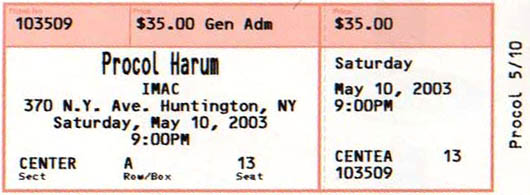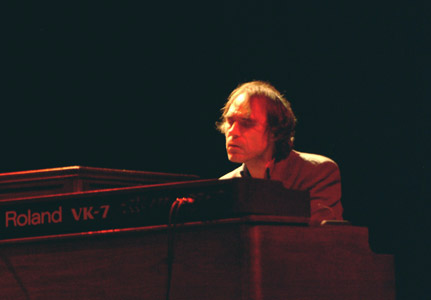The closing of the Inter-Media Art Center, a longtime showcase for innovative popular music in Huntington, saddened fans throughout the region who will miss its quality programming, state-of-the-art sound and welcoming ambience. But unlike the shutterings of so many other former institutions across a wide spectrum of American life over the past year, IMAC was neither a victim of a grim economy or callous corporate calculation.
Yes, there were issues with the landlord and the building. But I believe there was an intuitive sense on the part of founder-executive director Michael Rothbard and partner and co-founder Kathie Bodily that it was time to pull the plug – that somehow their idea had run its course in its current space.
I don't believe that IMAC is done with Huntington, or vice versa. Rothbard has said as much to me and anyone else who asks about the closing. But if and when it comes back, even if it's in a sparkling architectural dream of a new building, it won't be the same. An era has passed: the era of the mom-and-pop musical destination.
 IMAC
was just about the last one left in this region. I recognized that same
kicked-in-the-gut feeling at the disappearance of My Father's Place in Roslyn in
1987 after 16 years, the Bottom Line from Greenwich Village in 2004 after 30;
and CBGBs from the Bowery in 2006 after 33. You'd go to My Father's Place and
look for Michael "Eppy" Epstein; at CBGB, owner Hilly Kristal was always at the
door; at the Bottom Line, you'd see for the public face of the operating
partnership, Allan Pepper. They were at just about every show. Their presence
offered comfort, a sense that not only would the business function smoothly, but
that you were in the living room of a friend who often had very talented people
over to play.
IMAC
was just about the last one left in this region. I recognized that same
kicked-in-the-gut feeling at the disappearance of My Father's Place in Roslyn in
1987 after 16 years, the Bottom Line from Greenwich Village in 2004 after 30;
and CBGBs from the Bowery in 2006 after 33. You'd go to My Father's Place and
look for Michael "Eppy" Epstein; at CBGB, owner Hilly Kristal was always at the
door; at the Bottom Line, you'd see for the public face of the operating
partnership, Allan Pepper. They were at just about every show. Their presence
offered comfort, a sense that not only would the business function smoothly, but
that you were in the living room of a friend who often had very talented people
over to play.Each also had excellent, individual musical taste. CBGB, of course, was synonymous with punk rock; the Bottom Line thrived [throve!] as a showcase for Manhattan's once-thriving music industry. My Father's Place drew from both – from the Ramones to Bruce Springsteen and beyond. Each of these clubs was led by people who had developed long, deep and trusting contacts among artists, managers, labels and booking agents.
IMAC operated in a similar manner, but like every mom-and-pop, with its own twists and rhythms. In its early days, I thought of it as a niche hall for the form of gently funky instrumental music known as jazz fusion, or its even more melodic first cousin, smooth jazz. In fact, the final act to perform at IMAC was, fittingly, self-described smooth jazz singer and musician Bobby Caldwell.
But any kind of jazz theater would have been impossible to sustain for 26 weeks, much less 26 years, on Long Island. Instead, IMAC broadened its niche to serve . . . other niches. In fact, under the pop music umbrella, it may have been the nichiest niche music center in the entire region, with Cajun, bluegrass, zydeco and all kinds of indigenous American roots music, including blues and jazz; African, reggae and other world music; as well as singer-songwriters with loyal, long-term followings, especially among baby boomers.
 As
I write, I'm looking at an IMAC poster covering a period from 2003. The
headliners included reggae band Third World; Cajun music veterans Beausoleil;
another Louisiana band, jam rockers the Radiators; guitar aficionados' favorite
folky, David Bromberg; introspective singer-songwriter Joan Armatrading;
reunited 1960s British rock band Procol Harum; instrumental rock band the
Dixie Dregs; and yes, a selection of jazz acts, from the Caribbean Jazz Project
to Japanese keyboard player Keiko Matsui.
As
I write, I'm looking at an IMAC poster covering a period from 2003. The
headliners included reggae band Third World; Cajun music veterans Beausoleil;
another Louisiana band, jam rockers the Radiators; guitar aficionados' favorite
folky, David Bromberg; introspective singer-songwriter Joan Armatrading;
reunited 1960s British rock band Procol Harum; instrumental rock band the
Dixie Dregs; and yes, a selection of jazz acts, from the Caribbean Jazz Project
to Japanese keyboard player Keiko Matsui.A lineup like this is not "booked" as much as it is curated. IMAC's shows were not based on who was hot on the charts. It didn't matter whether any of the artists in that list had new albums or songs on the radio – most, if not all of them, most assuredly did not. But each appealed to enough of a niche to be able to attract an audience, and there are dozens of such artists available for a promoter in touch with the needs and desires of his or her neighborhood. Which, if you're a boomer settled in the suburbs, means wanting to see musicians – in comfortable surroundings and not traveling long distances to see it.
And as a mom-and-pop nonprofit art center, IMAC seemed to suit the needs of its Long Island community fine. "It enriched the local culture," said Randy Langione, a musician who lives and teaches guitar in Huntington who was a frequent IMAC attendee. "People love to go out locally. A lot of people aren't going to travel to see a show, but to have it close by was a treasure."
And yet bookings like the 2003 Procol Harum (A Whiter Shade of Pale) show brought fans of the reunited band to IMAC from all over North America: The Procol Harum fan site carried reports of followers from South Carolina and Michigan at the show, as well as this dispatch from Canada: "Huntington is a Long Island town with much to be proud of, including a main street that people have looked after and cared for, epitomized by the IMAC (Inter-Media Art Center) theatre. When I called ahead to book my seat, the staff were friendly and helpful, amazed that someone would come from as far away as Canada to attend an IMAC concert. Their spirit of cooperation was a trademark of the place," wrote W. George Lovell of Kingston, Ontario. [this is an excerpt from George's book about Procol Harum in concert: get it here]
And here lies the challenge for any concert promoter today, especially at the many performing art centers that hope to match IMAC's longevity and success.
Rothbard likes to say that when IMAC came to its New York Avenue space in Huntington in 1983, he was the first to turn an abandoned suburban downtown movie theater into a nonprofit performing arts center, "to present a wide range of music not normally found on Long Island." Now, he no longer feels like a pioneer, since the Island is dotted with such venues: the Landmark in Port Washington, the Boulton Center in Bay Shore, the Patchogue Theater for the Performing Arts, the Westhampton Beach Performing Arts Center, and others, from Dix Hills to Sag Harbor.
But a check of their calendars shows many of these venues to be mixed-use variety: children's shows, cabaret, long-term community theater runs, comedy, even that most commonplace of bookings on the Long Island club scene, tribute bands.
Some of the artists at these welcome inhabitants of the Long Island cultural landscape may have played at IMAC in the past. Some of these institutions may want to develop their own legacy performers or niche acts: There are only so many Richie Havens or Buckwheat Zydecos or Yellowjackets to go around. And it would be commendable indeed if all of them offered the kind of curatorial niche, awareness and personal service of Rothbard, Bodily and Cleo – their golden retriever who freely wandered the lobby – in the little gem they created in downtown Huntington.